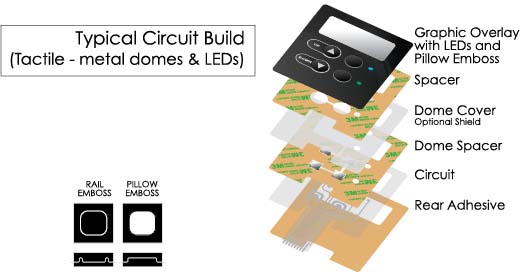Recognizing Membrane Switches Over: The Trick to Trustworthy and resilient Controls

What Are Membrane Layer Switches?
Membrane switches are a sophisticated option in the world of customer interface technology, combining capability and style effortlessly. These devices function as an interface in between customers and digital systems, incorporating a number of components right into a portable format. Normally constructed from adaptable, thin layers of materials, membrane layer buttons are created to respond to touch, allowing individuals to interact with machinery and digital devices successfully.
The main elements of a membrane button consist of a printed circuit layer, visuals overlay, and a spacer layer that protects against unexpected activation. The graphic overlay can be tailored to mirror brand identification or user choices, boosting looks while making sure usability. Membrane buttons are commonly utilized in various applications, consisting of clinical gadgets, consumer electronic devices, and commercial equipment, owing to their sturdiness and resistance to ecological factors such as wetness and dust.
One of the essential advantages of membrane switches is their ability to endure deterioration, making them excellent for high-traffic environments. Furthermore, they are light-weight and require very little space, enabling innovative styles in item advancement. Generally, membrane layer changes stand for a reliable and useful option for modern electronic user interfaces, weding technology with user-centric style principles.
Exactly How Membrane Layer Switches Work
The operation of membrane layer switches over hinges on a simple yet reliable device that translates individual input into electronic signals. These buttons include multiple layers, generally consisting of a visuals overlay, a spacer layer, and a circuit layer. When an individual presses the button, the leading layer deforms, allowing a conductive element in the circuit layer to make call with an equivalent conductive pad on the bottom of the graphic overlay. This call shuts the circuit and sends out a digital signal to the device, suggesting that the button has been activated.
The style of membrane layer switches can vary, but they usually incorporate domes or tactile elements to give comments to the user, enhancing the general experience - membrane switch. The products utilized in membrane layer buttons, such as polyester or polycarbonate, add to their toughness and resistance to ecological factors, consisting of dampness and dust. Furthermore, the published circuits are commonly encapsulated, which secures them from damage over time.
Benefits of Membrane Layer Switches

Furthermore, membrane layer switches are understood for their longevity. Constructed from durable products, they are immune to dust, moisture, and physical wear, which dramatically expands their life-span contrasted to standard mechanical buttons. This toughness makes them particularly ideal for high-traffic environments and applications needing durability.
Another considerable advantage is the simplicity of cleansing and maintenance. The smooth surface of membrane layer changes decreases dirt accumulation and is usually impervious to spills, look here making them excellent for settings that require constant sanitization.
In addition, membrane switches use a structured profile, bring about a thinner design that can be incorporated into various tools without adding mass. This function not just boosts the visual charm however additionally adds to an extra ergonomic product style.
Applications of Membrane Switches
Functional and easy to use, membrane layer switches discover applications throughout a large range of markets, consisting of clinical gadgets, customer electronic devices, and industrial equipment. In the clinical field, these buttons are indispensable to tools such as analysis tools, client monitoring systems, and infusion pumps, where integrity and simplicity of cleaning are critical. Their great post to read capability to keep and stand up to extreme environments functionality makes them ideal for such applications.

In consumer electronic devices, membrane layer buttons are made use of in items like microwaves, washing machines, and remotes - membrane switch. Their sleek layout permits user-friendly interface, enhancing the general individual experience while offering toughness and resistance to use and tear
Commercial devices also gains from membrane buttons, particularly in control panels for machinery and automation systems. These switches use protection versus dirt and dampness, ensuring consistent efficiency in tough environments. In addition, their personalized functions enable manufacturers to customize them to particular operational demands, boosting performance and functionality.
Choosing the Right Membrane Layer Switch Over
When selecting a membrane layer button, it is vital to take into consideration numerous elements that affect efficiency and suitability for specific applications. The key factors to consider include environmental conditions, responsive comments, durability, and layout specs.
First, examine the operating setting; switches revealed to dampness, chemicals, or severe temperatures require specific materials to guarantee longevity and performance. Next off, examine the demand for tactile feedback. Depending on individual communication, some applications might profit from a responsive action to validate activation, while others might like a non-tactile style for visual factors.
Durability is an additional crucial aspect; membrane layer switches ought to be developed to withstand regular use, effects, and abrasion. Ensure the selected switch can sustain the expected lifecycle, particularly in high-usage scenarios.

Final Thought
In verdict, membrane switches offer as important parts in the style of long lasting and reputable control systems across various markets. The convenience of membrane changes enables for customized remedies that meet certain functional demands, strengthening their value in contemporary innovation.
Membrane changes represent a crucial facet of contemporary interface style, blending performance with strength in various applications.Membrane buttons are an innovative service in the world of customer interface innovation, combining performance and layout Home Page flawlessly. Usually created from flexible, slim layers of products, membrane layer buttons are created to respond to touch, making it possible for customers to interact with equipment and electronic gadgets successfully.
The design of membrane buttons can vary, however they frequently incorporate domes or responsive aspects to offer responses to the individual, improving the total experience.In verdict, membrane switches over serve as vital parts in the design of long lasting and reliable control systems across different markets.